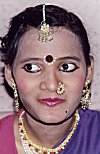
Yellow leaves and green flowers.
|  |
 | 
Parrots, elephants, deer, peacocks, tigers are used to embellish the exquisite silk sarees.
|

Highly skilled weavers produce excellent brocades of different animals among floral designs.
|  |
 | 
Embroidered Elephants
A mosaic pattern produced by weaving geometrical elephant motifs |

"Tie and dye" (Bandhani) is an ancient craft still practiced in Rajasthan. It is complex method of embellishing sarees by tying tiny knots that from the design and then dyeing the fabric. The knotted area remains uncolored. The process is repeated until t
|  |
 | 
"Appliqué" or patchwork is an integral part of the textile crafts of Gujarat and Rajasthan.
|

Sarees of the East
The tribal women of Nagaland, Mizoram, Tripura, Arunachal Pradesh, Manipur weave their textile on the traditional back-strap or loin-looms. It can be set up instantly and folded up and put away whenever women are not working. |  |
 | 
Very simple geometrical designs are produced on inexpensive sarees.
|

The Himalayan mountain goat's wool is hand-spun and woven into "Pahsmina" shawls.
|  |
 | 
Nine yard silk saree.
|

Portrait of Parijnanashram Swamiji
Parijnanashram Swamiji led the Chitrapur Muth |  |
 | 
Picture of a Hindu Pontiff
Pontiff of Chitrapur Muth - Sadyojata Shankarashrama Swamiji |

The Swamiji of the Gokarn Paratgali Muth
|  |
 | 
Pontiff of Kashi Muth, Cochin
Picture of Sudhindratirtha Swamiji |

Raghavendra Swamiji Offering Prayers to a Linga
|  |
 | 
A young girl with her lots of jewelry.
Performance of Krishna-Parijat |

"Jewelry Enhnaces the Womanhood"
|  |
 | 
"Don't I look like a bride, uncle?"
|
![]()
